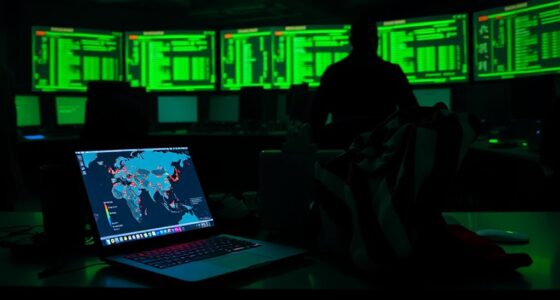
As cyber threats continue to evolve, Chinese cyber-espionage has emerged as a significant concern for nations and corporations alike. You mightn't realize it, but the tactics employed by Chinese cyber-espionage units have grown increasingly sophisticated. These units, including specialized Military Network Warfare Forces within the People's Liberation Army (PLA), focus on both attacking and defending network infrastructures. They operate under the oversight of the Ministry of State Security (MSS) and the Ministry of Public Security (MPS), but it doesn't stop there. Civilian groups often engage in network attacks, sometimes with unofficial government ties, blurring the lines between state and non-state actors.
Chinese cyber-espionage tactics are increasingly sophisticated, blending state and civilian efforts to target global networks.
You'll find that these cyber-espionage tactics have transitioned toward more stealthy approaches, utilizing techniques like zero-day exploitation and Living-Off-The-Land (LotL). By taking advantage of existing system tools, these hackers minimize the chance of detection. Additionally, they've begun to compromise software supply chains as a means to infiltrate networks, creating a multifaceted threat landscape. The use of botnets and proxy networks helps disguise their activities, making it hard for organizations to trace back to the original source.
Targeting various sectors, Chinese cyber-espionage aims at both commercial and military technologies. You should be aware that intellectual property theft is a key goal, with sectors like IT, healthcare, and energy being frequent targets. This aligns with China's strategic objectives, including the "Made in China 2025" initiative, which seeks to acquire critical technologies to enhance national capabilities. The global reach of these operations extends beyond the U.S., infiltrating markets in Africa and Asia. In fact, 69% of espionage incidents occurred after Xi Jinping took office in 2012, highlighting the increasing focus on strategic objectives.
The statistics on cyber-espionage incidents underscore the scale of this issue. Since 2000, over 224 reported cases of espionage in the U.S. highlight that nearly half involved cyber tactics. A significant portion of these incidents—54%—targeted commercial technologies, while 29% focused on military advancements. You can imagine the economic impact, with billions of dollars lost due to these ongoing threats.
Advanced Persistent Threats (APTs) like APT5, APT15, and APT31 are at the forefront of these operations. They employ strategies like Operational Relay Box Networks (ORBs) to obscure their origins and maintain access to high-value networks. By utilizing both custom tools and publicly available software, they exploit security flaws, illustrating the complexity of the threat landscape.
As these groups expand their reach into regions like Africa and the Caribbean, the implications for global cybersecurity are profound. You must remain vigilant; the threat of Chinese cyber-espionage is growing, and it affects us all.









